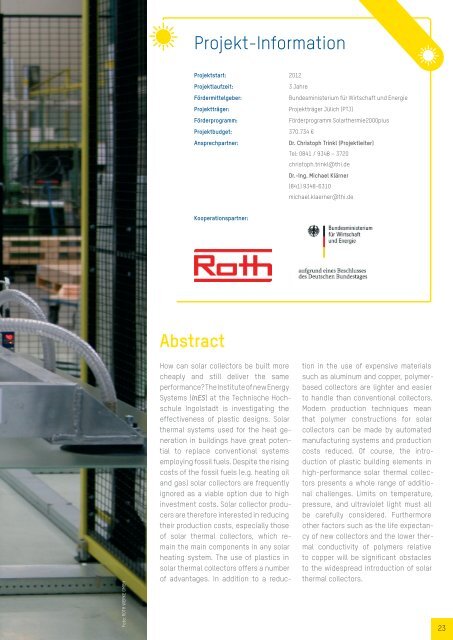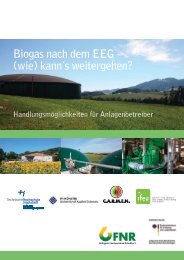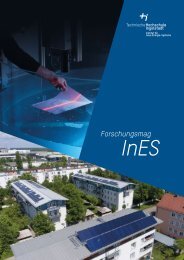Energie mit Zukunft
Forschungsmag 2015 des Instituts für neue Energie-Systeme (InES) an der Technischen Hochschule Ingolstadt (THI)
Forschungsmag 2015 des Instituts für neue Energie-Systeme (InES) an der Technischen Hochschule Ingolstadt (THI)
Erfolgreiche ePaper selbst erstellen
Machen Sie aus Ihren PDF Publikationen ein blätterbares Flipbook mit unserer einzigartigen Google optimierten e-Paper Software.
ProjektInformation<br />
Projektstart:<br />
Projektlaufzeit:<br />
Förder<strong>mit</strong>telgeber:<br />
Projektträger:<br />
Förderprogramm:<br />
Projektbudget:<br />
Ansprechpartner:<br />
2012<br />
3 Jahre<br />
Bundesministerium für Wirtschaft und <strong>Energie</strong><br />
Projektträger Jülich (PTJ)<br />
Förderprogramm Solarthermie2000plus<br />
370.734 €<br />
Dr. Christoph Trinkl (Projektleiter)<br />
Tel: 0841 / 9348 – 3720<br />
christoph.trinkl@thi.de<br />
Dr.-Ing. Michael Klärner<br />
(841) 93486310<br />
michael.klaerner@thi.de<br />
Kooperationspartner:<br />
Foto: ROTH WERKE GMBH<br />
Abstract<br />
How can solar collectors be built more<br />
cheaply and still deliver the same<br />
performance? The Institute of new Energy<br />
Systems (InES) at the Technische Hochschule<br />
Ingolstadt is investigating the<br />
effectiveness of plastic designs. Solar<br />
thermal systems used for the heat generation<br />
in buildings have great potential<br />
to replace conventional systems<br />
employing fossil fuels. Despite the rising<br />
costs of the fossil fuels (e.g. heating oil<br />
and gas) solar collectors are frequently<br />
ignored as a viable option due to high<br />
investment costs. Solar collector producers<br />
are therefore interested in reducing<br />
their production costs, especially those<br />
of solar thermal collectors, which remain<br />
the main components in any solar<br />
heating system. The use of plastics in<br />
solar thermal collectors offers a number<br />
of advantages. In addition to a reduction<br />
in the use of expensive materials<br />
such as aluminum and copper, polymerbased<br />
collectors are lighter and easier<br />
to handle than conventional collectors.<br />
Modern production techniques mean<br />
that polymer constructions for solar<br />
collectors can be made by automated<br />
manufacturing systems and production<br />
costs reduced. Of course, the introduction<br />
of plastic building elements in<br />
highperformance solar thermal collectors<br />
presents a whole range of additional<br />
challenges. Li<strong>mit</strong>s on temperature,<br />
pressure, and ultraviolet light must all<br />
be carefully considered. Furthermore<br />
other factors such as the life expectancy<br />
of new collectors and the lower thermal<br />
conductivity of polymers relative<br />
to copper will be significant obstacles<br />
to the widespread introduction of solar<br />
thermal collectors.<br />
23

















